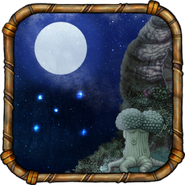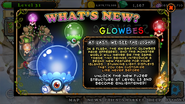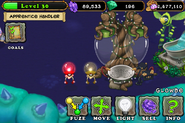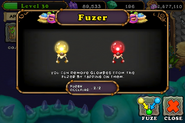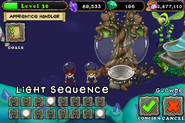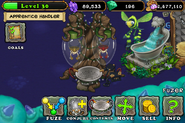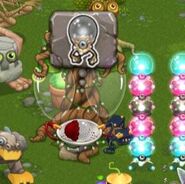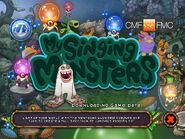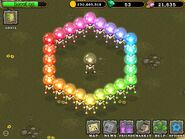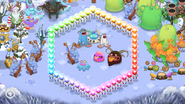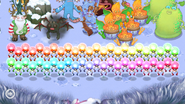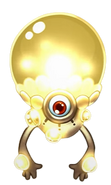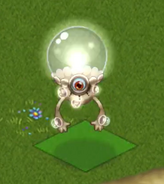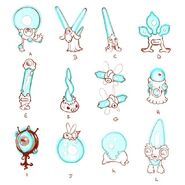| “ | Within the blink of an eye, these mysterious beings flashed into existence and began populating the Monster world. While Singing Monsters may be in the dark about their origin (they make no sound, which completely baffles them), they have been enlightened as to their purpose: to help create amazing light displays for the Islands! Glowbes have officially been welcomed into the Monster family, and are here to stay! | ” |
Description[]
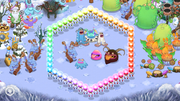
All Glowbes from primary to quinary, arranged by a player in a hex formation
Glowbes are a special kind of Monster that don’t produce sound, but rather emit light. According to the game’s lore, Glowbes hail from the Prism Dimension, a universe separate from the Monster World. Glowbes can be accessed in-game via the Fuzer structure, which allows you to conjure either a Red, Yellow, or Blue colored Glowbe. Two different colored Glowbes can then be fuzed into one Glowbe with a color combined from its parents. This can be done nearly unlimited times, to create a vast array of colors. In addition to being able to customize their color, players can also alter the light sequence to create animated light displays. Also, they are used to become in different colors And Your very own colors
Although referred to as Monsters, Glowbes do not mechanically behave like a Monster in any right. They do not produce any currency, have any likes, liked by any monsters, cannot be leveled up or biggified, and take up no beds.
Note that for players with photosensitivity, epilepsy, or some other related issue, Glowbe light displays can be disabled in the Settings.
Using Glowbes[]
Glowbes can be placed on all islands except The Colossingum, Tribal Island, Gold Island and Magical Nexus. A Glowbe has a single color, and blinks on and off in a user-programmable pattern. Glowbes are "conjured" in a structure called a Fuzer. Like the Glowbes, the Fuzer is unlocked at level 13. On Composer Island, a Fuzer is not needed and cannot be placed there.
When a Glowbe is "conjured" in the Fuzer, it may be chosen to be red, yellow, or blue. In addition, two Glowbes can be "fuzed" to create a new, secondary color like green, purple, or orange. It's also possible to fuze a primary and secondary color to make a tertiary color -- for instance, fuzing red with green yields a puce Glowbe; fuzing red with orange yields a reddish-orange Glowbe. Other color combinations also can result in a quaternary color or a quinary color. Quaternary colors are created by fuzing a primary and a tertiary color, or two secondary colors. Quinary colors can be created by fuzing a primary and a quaternary color together, or a secondary with a tertiary color; fuzing orange with purple yields a very dark blue color.
Glowbes can be changed to adjust the timing of when each Glowbe illuminates. When the function is used wisely, it can have stunning effects on your island.
On Composer Island[]
Glowbes first appeared on Composer Island in Version 2.0.6. They can be rearranged and form any possible set of visibly different Glowbe colors. They also occupy no beds at all and do not need food, as usual.
On Composer Island, Glowbes do not require fuzing. They can be bought as normal for 1000 ![]() each. Their colors can be altered by tapping on them and pressing "compose" to edit their timings of their colors. Using sharps and flats also modifies the color's appearance.
each. Their colors can be altered by tapping on them and pressing "compose" to edit their timings of their colors. Using sharps and flats also modifies the color's appearance.
Combinations[]

Diagram of list of combinations up to quinary
The following tables shows some of the color combinations. Since it appears to be possible to combine any pair of Glowbes, creating finer and finer gradations of color, no table can show all of the possibilities. It doesn't matter which color is on the right side and which is on the left.
Primary Colors[]
These are the only three colors that are impossible to make through fuzing two different Glowbes.
| First Color | Second Color | Third Color |
|---|---|---|
| Red | Yellow | Blue |
Secondary Colors[]
Here, you mix primary colors with primary colors.
| First Color | Second Color | Fuzed Color |
|---|---|---|
| Red | Yellow | Orange |
| Red | Blue | Purple |
| Yellow | Blue | Green |
Tertiary Colors[]
Tertiary colors are made by mixing one primary color with a secondary color.
| First Color | Second Color | Fuzed Color |
|---|---|---|
| Main Tertiaries | ||
| Red | Orange | Vermilion |
| Yellow | Orange | Amber |
| Yellow | Green | Chartreuse |
| Blue | Green | Teal |
| Blue | Purple | Violet |
| Red | Purple | Magenta |
| Complementaries | ||
| Red | Green | Auburn |
| Yellow | Purple | Gold |
| Blue | Orange | Puce |
Quaternary Colors[]
Quaternary colors are made by mixing one primary color with a tertiary color (vice-versa works too), or by mixing two secondary colors.
| First Color | Second Color | Fuzed Color |
|---|---|---|
| Main Quaternaries | ||
| Red | Vermilion | Scarlet |
| Orange | Vermilion | Tangerine |
| Orange | Amber | Apricot |
| Yellow | Amber | Buttercup |
| Yellow | Chartreuse | Lime |
| Green | Chartreuse | Spring Green |
| Green | Teal | Viridian |
| Blue | Teal | Cerulean |
| Blue | Violet | Indigo |
| Purple | Violet | Periwinkle |
| Purple | Magenta | Fuchsia |
| Red | Magenta | Crimson |
| Other Quaternaries | ||
| Orange | Purple | Dark Red-gray |
| Green | Orange | Dark Yellow-gray |
| Green | Purple | Dark Blue-gray |
| Blue | Teal | Icy Blue |
| Purple | Orange | Dark Brown (color of Rare Bowgart) |
| Magenta | Blue | Somewhat between pink-purple and puce |
| Auburn | Gold | Chocolate |
| Gold | Puce | Desaturated Green |
| Puce | Auburn | Desaturated Purple |
Quinary Colors[]
Quinary colors are made either by mixing one primary color with a quaternary color, or by mixing a secondary color with a tertiary color. Vice-versa works for both combinations.
| First Color | Second Color | Fuzed Color |
|---|---|---|
| Orange | Violet | Very Dark Blue |
| Green | Teal | Mint Green |
| Chocolate | Puce | Almost-black Blue |
| Auburn | Desaturated Green | Almost-black Red |
| Gold | Desaturated Purple | Almost-black Yellow |
Senary Colors[]
Senary colors are made either by mixing two tertiary colors, a secondary and quaternary color, or one primary with a quinary. Vice versa does work with the last two combinations.
| First Color | Second Color | Fuzed Color |
|---|---|---|
| Almost black <color> | Red | Maroon |
| Blue | Navy | |
| Yellow | Olive |
Beyond Quinary and Senary[]
The Glowbes can be combined to virtually any level of color variation, but the number of possibilities increases geometrically. With smaller differences between colors, it isn't possible to provide "recipes" that everybody can agree on -- people perceive color differently, and use color names differently. Of course, BBB can confirm the currently-discovered color names for Glowbes, but no one has contacted them about this or there isn't any official names made by BBB for the Glowbe colors.
Colors[]
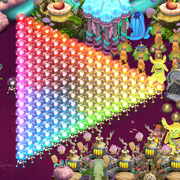
A triangle formed by mixing Glowbes to find the "middle" in each point of the triangle, then mixing secondary, tertiary, quaternary, and quinary colors from there.
Usually, when different-colored lights are combined, the result comes from an additive color scheme. For example, on a television or computer monitor, red and green combine to give yellow. However, the combinations of Glowbes work similar to, but not exactly the same as, a subtractive color system, as with mixing paints. To predict what color will result from a given combination of Glowbes, you may find it useful to think of each Glowbe as having a white light inside, shining through a transparent colored shell. The colors of the shells from the two "parents" would be mixed and painted onto the shell of the "child".
When you're combining multiple Glowbes, the order of the mixing is important because it affects the final proportions. Blue and yellow combine to give a green: ½ blue and ½ yellow. If this is combined with red, the resulting red-brown color is ½ red, ¼ blue, and ¼ yellow. But if you combine red and yellow to give orange (½ red and ½ yellow) and then combine that with blue, you get indigo-blue from the ½ blue, ¼ red, and ¼ yellow. Red and orange give reddish-orange: ¾ red, ¼ yellow.
Ultimately, the color mixing of Glowbes does not follow mathematical ideals exactly, leading to discontinuities across its color space. This is most easily seen with colors that are the result of Fuzing all 3 base colors of Glowbes, but can also be seen in, for example, a red-to-blue gradient as shown in the color triangle image.
'White' Glowbes[]
If you managed to create a Glowbe that was ⅓ Red, ⅓ Yellow, and ⅓ Blue, you would end up with a Glowbe showing no color at all -- that is, 'White' (grey). It's mathematically impossible to get exactly ⅓R + ⅓Y + ⅓B, but you can get arbitrarily close with sufficient effort. Standard computer, tablet, and phone displays only use 8 bits to describe the color levels of red, green, and blue. That's a precision of 1 part in 256, or about 0.4%. This means that in practice, due to rounding, the percentages are allowed to be about 0.2% apart and still have the same display color values.
Any alternating Fuzing of one primary (Red, Yellow, or Blue) with its opposite secondary (Cyan, Magenta, Orange) Glowbe should quickly result in the required color mix. The below table uses the colors Blue and Orange. Due to the aforementioned display technology limitations, the first primary mix is repeated twice before alternating, which saves a few steps.
Orange = Red + Yellow. Always pre-fuze these before fuzing with the results. E.g. Fuzing Blue with Orange is not the same as fuzing Blue with Red (giving Magenta), and then fuzing Magenta with Yellow!
Mix as follows:
| First Glowbe | Second Glowbe | Result Glowbe | Number of steps taken | % Red | % Yellow | % Blue |
|---|---|---|---|---|---|---|
| Red | Yellow | Orange | 3 (2 x Conjure, 1 x Fuze) | 50 | 50 | 0 |
| Blue | Orange | Result A | 5 (+1 x Conjure, 1 x Fuze) | 25 | 25 | 50 |
| Result A | Blue | Result B | 7 (+1 x Conjure, 1 x Fuze) | 12.5 | 12.5 | 75 |
| Result B | Orange | Result C | 11 (+2 x Conjure, 2 x Fuze) | 31.25 | 31.25 | 37.5 |
| Result C | Blue | Result D | 13 (+1 x C, 1 x F) | 15.62 | 15.62 | 68.76 |
| Result D | Orange | Result E | 17 (+2C,2F) | 32.81 | 32.81 | 34.38 |
| Result E | Blue | Result F | 19 (+1C,1F) | 16.41 | 16.41 | 67.18 |
| Result F | Orange | Result G | 23 (+2C,2F) | 33.2 | 33.2 | 33.6 |
| Result G | Blue | Result H | 25 (+1C,1F) | 16.6 | 16.6 | 66.8 |
| Result H | Orange | White (grey) | 29 (+2C,2F) | 33.3 | 33.3 | 33.4 |
Gallery[]
Notes[]
- Their name is a combination of the two words "Glow" and "Globe".
- In the 2.4.1 update, Glowbes were made available on both Celestial and Wublin Island.
- In the 2.0.6 update, Glowbes were made available on Composer Island.
- In the 2.1.0 update, Glowbes were given notes of length (equivalent to extending the length of the light flash).
- Glowbes are more like decorations than Monsters. They do not take up any beds in a Castle, do not need Food, and do not level up.
- The Monster Handlers have stated multiple times that Glowbes are technically decorations as opposed to Monsters, but since 2.0.6, they have been declared "Honorary Monsters" by the Handlers.
- While in other islands Glowbes are counted as decorations instead of Monsters, this is not the case in Composer Island, as they actually count as Monsters there.
- This is reflected on the fact that they are bought directly from the Monsters section in the Market, rather than being conjured from the Fuzer, which, like other structures, is unavailable in Composer Island.
- Additionally, the Glowbe portrait can only be unlocked by placing a Glowbe on Composer Island, while placing one on any other island doesn't unlock it.
- Because of their unique nature, they appear on the most islands of any monster, being only absent in Gold Island, Tribal Island and The Colossingum.
- According to the TBT Thanksgiving special, the Glowbes were originally going to be named "Blinky Buddies". (33:24)
- Unlike Monster breeding, the act of fuzing two Glowbes is destructive to the originals.
- Glowbes do not have unique names, and cannot be renamed.
- Instead, they can be renamed in Composer Island, but every Glowbe’s default name shows up as “Glowbe”.
- Do not be fooled by the middle color of the light - the true color of Glowbes can be seen in their glow in front of a neutral grey background, like some areas of the Dragon Tower's base.
- The Glowbe's cup and gloves have a slightly beige tint.
- Glowbes currently do not do the "squish and bounce" interaction when tapped on.
- Glowbes are featured in the game Jammer Splash as a system to tell how good you did on a level point-wise.
- In the files of the 2.0.4 update of My Singing Monsters, a Glowbe egg and a Bubblerite Glowbe portrait (the portraits you would normally see in Composer Island, the memory game, the Breeding Structure, and the first iteration of the Book of Monsters) was found. They have since been used for the Glowbes on Composer Island, in Version 2.0.6.
- The egg has also been used for the Fuzer when a Glowbe is conjured.
- It has been confirmed in a My Singing Monsters Live stream that they communicate by blinking their lights, and gain nutrition from the light of other Glowbes.
- In the 57th episode of My Singing Monsters Live it was said that only Glowbes appear to live in the Glowbe's home world - described as a 'vast expanse', unlike the Thumpiesverse and Thingia.
- This dimension was confirmed to be the dimension beyond the Prism Gate portal in the 58th episode and re-affirmed in later episodes.
- In the same live stream, Monster-Handler Matt suggested that the Glowbes in their home dimension are no color and all colors at once, in a color imperceptible to Humans, and the act of conjuring a Glowbe causes the Glowbe to attain one of the three primary colors available in the Monster world.
- In the same live stream, Monster-Handler Matt entertained the notion of a 'black' Glowbe that absorbs light, rather than emitting it, as a result of a Fuzer malfunction while conjuring/fuzing.
- Glowbes are known as "Buddy" according to the game files.
- A Glowbe is one foot ten inches tall.
- By doing a now patched glitch, you could see that in Composer Island's Monster book, the Glowbes were catalogued as Seasonal Monsters.
- Two concepts of Glowbes eventually became a Monster and a Decoration.
- When tapped on in the Memory Game, Glowbes will play no sound.
- On certain Islands, Glowbes are animated out of sync with the song.
- When a Glowbe is flipped, it can be seen without any color for a single frame.
- Glowbes are always animated as 140 BPM, since they do not sing. As such, islands like Fire Oasis or Light Island don't work well with Glowbes, since the light sequence can be out of sync.


